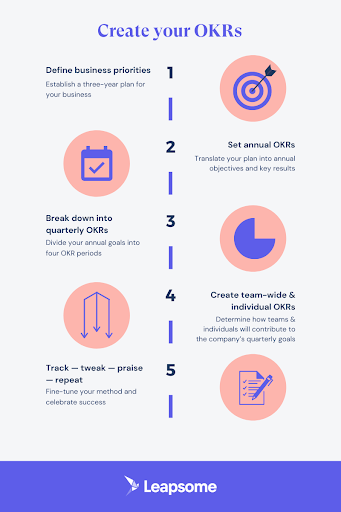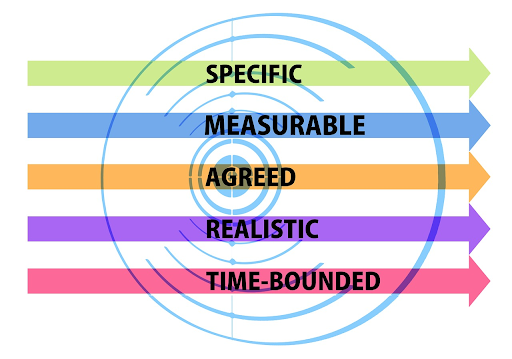Kudos if your company has implemented a comprehensive approach for setting and achieving objectives.
However, here’s the harsh reality. No goal-setting approach can thrive sans buy-in and synchronization at all levels of your company.
Executives are the ones setting the overarching goals. Depending on your business, these could be yearly, quarterly, or monthly.
What is essential is — the goals are explained effectively to leaders, who are in charge of creating their respective targets and coordinating with their staff.
Only then will workers be able to set their own personal goals for which they’re held responsible.
If your firm is new to a goal-setting strategy, employees may get confused. To help you and your staff, here are 7 tips and tools to get you started!
7 Powerful Tips and tools to determine your team’s objectives
Setting high-level objectives may appear simple, but companies frequently fail to explain to staff how their job contributes to the statement of vision.
Now, these tips and tools shall help you get started with the process.
7 tried-and-tested methods to set your team’s goals
Listen to your team’s needs
Spend a while to meet your staff and learn about their career objectives. Being heard matters to both you and your employees.
It’s true that your employees were employed to serve a specific job inside your organization. But it is highly likely that they have their own personal development aims which you may be able to assist them with.
Now at the end what happens is, this approach filters back into the company and strengthens your product. When someone does well in their job, they benefit the company as well.
Specify milestones and revisit them each 6 months after you’ve figured out whatever they would like to do.
Maintain accountability among your team members
You can establish an in-house system to track duties linked with certain projects in order to effectively manage your crew and set targets.
Everyone in the organization should be accountable for maintaining their work list current and relevant. All of these mini tasks can be linked to larger initiatives and goals.
Employees must also keep reports at the inception and conclusion of each shift – which keeps everyone on track. Furthermore, maintain a transparent system ensuring that everyone is held to account.
Employees can observe and encourage one another because the task lists are visible to all.
Publicize your goals
Ensure that you have transparency around corporate success to assist your employees with setting objectives.
You can have software with dashboards, which give a real-time overview of your monthly / quarterly targets to keep staff members engaged and enthused.
You may also maintain a reminder system which gives regular notifications and serves as a drive for employees to complete minor day-to-day chores.
This approach will enable your teammates to monitor their daily progress as well as understand how it relates to your long-term objectives. It’s an effective way of communicating to your team about your goals and also how close they are to accomplishing them.
Highlight how meeting targets impacts the bigger picture
It’s a tried-and-tested approach to link short-term goals to long-term organizational objectives. However, you don’t need to show them on a big platform to make them effective.
The most crucial part is to ensure that your staff is familiar with the regular corporate goals and also how their ambitions relate to them.
Showing how individual goals relate to the corporate future priorities boosts their participation and helps them understand why goals are developed.
When you get their support, it serves as a win-win situation for everybody.
Quantify key objectives
It will be difficult for members of your team to reach their objectives if the milestones you establish for them are unclear and inconsequential. It will also be tough for you to measure their progress.
Setting quantifiable objectives is essential. The target should be measured precisely such that there is no doubt about whether it has been achieved.
It might be a set quantity of sales, layouts, website releases, support sessions, or pages created for your staff. We may segment it further into quarterly, monthly, or yearly chunks because each member of the team is aware of the target.
A clever way to ensure this is to hold performance review meetings each quarter or once per year. Managers and staff give each other input and set goals for progress. Regular reviews assist you in keeping your team members engaged and productive, ensuring continual improvement with time.
Link goal achievements to incentives
Although you must emphasize on the importance of tying any rewards to objectives that appeal to your teammates’ strengths, you should also give importance to the openness and rewarding of goals achievement.
Incentive plans are useful for motivating team members. They are important for recognizing the efforts of your employees and encouraging them to try harder.
However, it’s critical that your strategy is oriented toward showcasing their abilities and promoting positive workplace behaviors, rather than the opposite. Achievements in each post will then be attainable as a result of this positive and harmonious development.
Setting a ridiculously high sales target and pairing this with a ludicrously fantastic incentive, for example, could result in a toxic environment, as your employees may go to unreasonable extremes to ensure sales.
When establishing rewards programs, keep your ideal business culture in mind, and customize any incentive structure to your workers’ talents and career ambitions.
Finally, create an action plan
Setting goals is useless without a strategy for achieving them. When do particular milestones have to be reached? How will you communicate with your personnel and track their progress to their objectives?
When you’re establishing achievable targets, make sure they’re backed up by a plan of action, which you should walk through with everyone. Use a method like hosting a quarterly meeting to keep track of your progress.
Allow your staff to participate in the strategic planning, allowing them to own and be responsible for the result. Let them pitch on how they’re going to get there. It makes no sense to create team objectives if nobody is present to hold them accountable.
7 powerful tools to track your team’s goals and objectives
OKRs
Objectives and Key Results — is what the name “OKRs” stands for. It’s a team and individual goal-setting solution that enables your company to build strong, specific targets with tangible results.
OKRs serve as a means to monitor progress, improve alignment, and motivate engagement in measurable objectives.
To support visions and goals, your OKRs must be quantitative, flexible, transparent, and agile. They’re frequently determined by your leadership and aren’t tied to salary or performance reviews.
Finally, OKRs let your company set high goals and afterwards accomplish them well over a period of a month.
Splitting targets into bite-sized, consumable pieces that could filter across all corporate divisions and functions helps in achieving more objectives and developing organizational alignment.
This serves as the basic framework and primary criterion for defining and designing a perfect and full-fledged OKR template.
KRAs
KRAs mean Key Result Areas, and it’s another great way to link your team with the bigger picture. KRAs are predicated on an employee’s job role, which are used to assign responsibilities to them.
Employees are solely responsible for achieving the KRAs which have been set for them. KRAs are just one piece of the puzzle. Your KRA as a copywriter, for example, is to produce material that performs well and ranks well.
This methodology performs a fantastic job at explaining things in simple terms without the use of measurements or jargon, for example.
Release new features within schedule if you’re a software engineer.
Improve the number of visits to the website via email campaigns if you’re an email marketing expert.
SMART goals
Specific, Measurable, Attainable, Realistic, and Timely aka SMART is an efficient goal-setting approach, which has been demonstrated to have a significant relationship with a firm ’s financial performance.
- Specific: The goal ought to have a clear, exceedingly specific target. If your aim is too broad, it would not be wise.
- Measurable: You should have the ability to accurately track your employees’ progress so as to decide when a target can be met.
- Attainable: Setting an excessively ambitious goal will make achieving it difficult. In the long term, this will sap one’s drive.
- Relevant: The goal you select should be something you’re interested in and it must be linked plus prove beneficial to a certain field.
- Timely: Putting a deadline on the goal helps organizations quantify it and stay on track.
KPIs
KPIs (Key Performance Indicators) are frequently used in consultancy and analytics. KRAs are just a type of KPI. This implies that an employee’s performance will be evaluated based on the information provided. KPIs can be properly measured.
For example, if a company’s article or feature ranks among the top 5 search results, that is a KPI for a writer and editor.
It’s an excellent approach to get a snapshot of current progress and does a brilliant job of measuring anything your staff might be doing.
The following KPIs might be used by a salesperson: the total value of the pipeline, per day inbound leads, and leads that are qualified. The individual should be aware of the current situation at all times.
MBO
The acronym MBO stands for Management by Objectives. Your leaders focus on what workers accomplish rather than how they accomplish it.
There exists several activities to acquire everyone’s support on these aims and objectives. However, these discussions and processes might take several months, and then they can eclipse successful operations.
MBO refers to the technique of establishing your top company goals and applying them to develop personal objectives. MBO approaches are intended to identify an individual’s primary objectives, which are then evaluated via group input.
This enables all your teammates to view their accomplishments in regards to the firm’s main initiatives as they execute their activities, bolstering synchronization between acts and consequences and boosting productivity significantly.
Graphic rating scale
A standard graphic scale employs numeric values to grade an employee’s relative progress in specific categories — like 1 to 5 and 1 to 10.
Behavioral elements such as ‘understands work activities’ or ‘partakes in decision-making” are frequently rated using scales.
They could also make a note on how often a person performs a specific task or behavior, such as ‘often’, ‘frequently’, ‘regularly’, ‘occasionally’, or ‘rarely’ arriving on time. Scales can be customized to fit your company’s needs.
360-degree feedback
This popular system considers comments, opinions, and judgments of the performance of the employee from the people alongside whom they engage in the firm.
Coworkers, bosses, and others may be included in this approach. You can notice good and unfavorable similarities and patterns as you examine input from a variety of sources.
You can also determine which locations may require more measurements and assistance.
Conclusion
We hope by the end of this write-up, you have gathered some ideas on how to start designing and implementing a full-fledged goal-setting and management system in your company.
HR Future Staff Writer
Do you have any other additions? Feel free to let us know in the comment section below!

















